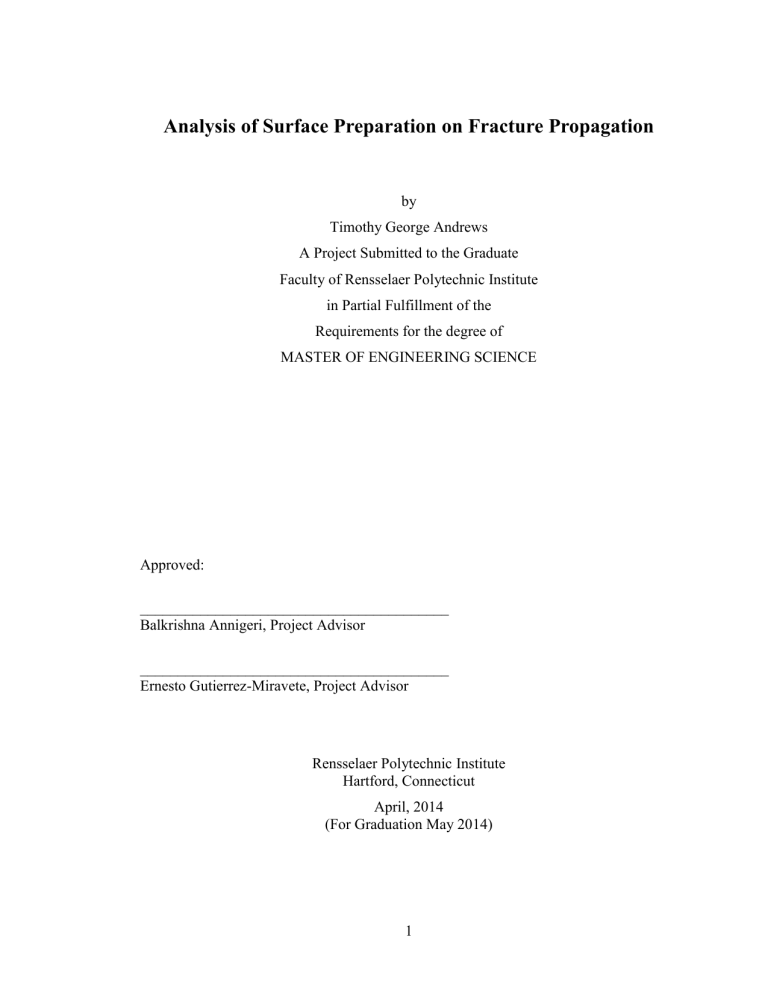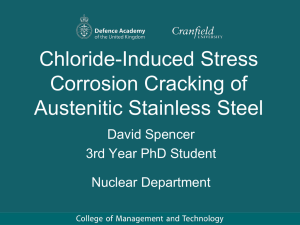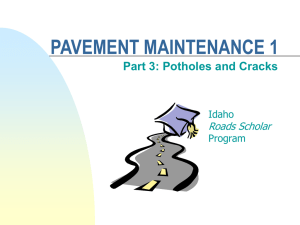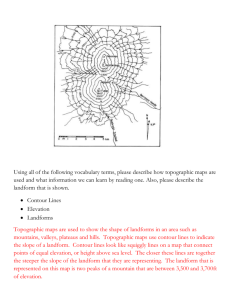Laser Shock Peening

Analysis of Surface Preparation on Fracture Propagation
by
Timothy George Andrews
A Project Submitted to the Graduate
Faculty of Rensselaer Polytechnic Institute in Partial Fulfillment of the
Requirements for the degree of
MASTER OF ENGINEERING SCIENCE
Approved:
_________________________________________
Balkrishna Annigeri, Project Advisor
_________________________________________
Ernesto Gutierrez-Miravete, Project Advisor
Rensselaer Polytechnic Institute
Hartford, Connecticut
April, 2014
(For Graduation May 2014)
1
.
© Copyright 2014 by
Timothy George Andrews
All Rights Reserved ii
CONTENTS
Analysis of Surface Treatment Effect on Crack Growth ........................................... 11
iii
LIST OF FIGURES
Figure 1. Schematic of Residual Stress and Operating Tensile Stress. ............................ 1
Figure 7. Residual Stress after Low Plasticity Burnishing in IN718. [3] ......................... 8
Figure 8. Residual Stress in a 4% cold worked hole in 5083 Aluminum. [4] .................. 9
Figure 9. Graphical Representation of the Residual Stress around a Cold-Worked Hole.
Figure 10. Geometry of Cracks used in NASGRO for Shot Peen, and Laser Peen
Figure 14. FRANC3D analysis of a 0.050”x0.200” corner crack. ................................. 17
Figure 15. FRANC3D Analysis of Shot Peened Al 2024. ............................................. 18
Figure 19. Crack Growth in LPB IN718 test data and analysis. [3] ............................... 22
iv
LIST OF TABLES
Table 1. Stress intensity in shot peened specimens from FRANC3D analysis. .............. 17
v
ACKNOWLEDGMENT
I would like to thank Dr. Balkrishna Annigeri for his guidance and patience. I also thank
Lars Vestergaard for his assistance and training in the use of NASGRO and Dr. Ernesto
Gutierrez-Miravete for his assistance. I thank my wife, Sandra Andrews, for her patience and encouragement. Finally, I thank United Technologies Corporation for their assistance throughout my graduate program. vi
ABSTRACT
Shot peening and other forms of surface treatment can beneficially affect the crack propagation properties of materials used in aerospace applications. Shot peening has been used for many decades as the most common method of surface treatment, but other methods include laser peening, low plasticity burnishing, and cold working of holes.
These methods all work by applying a layer of compressive stress on the surface, which acts to counter applied tensile stress.
The magnitude and depth of the compressive stress layers are publicly available for many materials in the literature. The effect on crack growth can be analyzed using commercially available crack growth analysis software, such as NASGRO and
FRANC3D. The analysis of the crack growth is done by using superposition to add the residual stress in the surface layer to an applied stress. The analysis results are compared to test results in the literature.
The analytical results did not match the test data well enough for engineering purposes for most of the surface treatments. The possible reasons for this are that the material properties in the software code might not match exactly with the test specimens, and that the crack propagation might not be semi-elliptical as the NASGRO code assumes. vii
1.
Introduction
Cracks in aircraft parts can lead to catastrophic failures, and therefore it is important to reduce crack growth. In order to do this, there are several methods of applying residual compressive stress to the surfaces of parts where cracks may form, including the following:
1.
Shot peening
2.
Laser shock peening
3.
Low plasticity burnishing
4.
Cold hole working
These methods all apply forces to the surfaces of metal parts in order to cause a compressive plastic stress. The compressive stress acts against applied tensile stress occurring in operation. Because the plastic stress partially offsets the tensile operating stress, the crack experiences lower effective tensile stress and grows less quickly, resulting in longer part life. This is shown schematically in Figure 1.
Figure 1. Schematic of Residual Stress and Operating Tensile Stress.
1
2.
Descriptions of Methods of Applying Residual Stress
2.1
Shot Peening
Shot peening bombards a surface of a part with small spherical shot made of metal, glass, or ceramic materials, typically in the size range of 0.004” to 0.040” (0.1 mm to 1.0 mm). These particles hit the surface hard enough to apply a compressive stress to the surface. The depth of the compressive stress is typically about 0.015” deep. This depth is enough to significantly increase the fatigue life of the part, and to slow the growth of shallow cracks that are formed. Below the layer of compressive stress, there is a layer of residual tensile stress, which is caused by the need to balance the layer of compressive stress. A schematic of the shot peening process is shown in Figure 2. A typical residual stress pattern in 2024 Aluminum plate caused by shot peening is shown in Figure 3, from Ludian et al. [1].
Figure 2. Schematic of Shot Peening Operation.
2
Figure 3. Residual Stress from a Shot Peening Operation in 2024 Aluminum, based on experimental data. [1]
Shot peening can be done at different intensities. The plot in Figure 3 shows three different levels: 0.1T coverage, 1T coverage, and 4T coverage. Coverage at 1.0T refers to peening for the amount of time needed to cover the entire specimen. Coverage at
0.1T refers to peening for 0.1 times the amount of time needed to cover the entire specimen, and 4T coverage is four times the amount of time needed to cover the entire specimen. The plot shows that the specimen can be peened with significant residual compressive stress at one tenth the time required for full coverage, which can result in significant cost savings while still retaining much of the advantage of the surface treatment.
3
Shot peening is the most common and least expensive process for surface treatment.
This process has been used in industry for decades and is well understood. The process has some imprecision due to the randomness of the location of the impacts of the shot.
Because of this, there is some possibility that some areas will have more residual stress than other areas, and thus the process will not be as repeatable and predictable as other forms of applying residual stresses.
2.2
Laser Shock Peening
Laser shock peening is a process that applies a compressive stress layer much deeper than shot peening. In this process, an ablative layer is applied to the surface of the part.
This layer is usually black paint or black tape. A layer of water is run over the black ablative layer. A high energy laser is aimed at the part, and the ablative layer absorbs the energy of the laser, heating the water into plasma. The beam is sent in pulses of tens of nanoseconds, creating rapid expansion of the ablative layer. This rapid explosion creates a shock wave that runs through the part, and this creates a compressive stress layer, analogous to shot peening, but penetrating deeper into the material. The layer of water contains the explosion and forces the shock wave into the part. A schematic of laser shot peening is shown in Figure 4.
4
Figure 4. Schematic of Laser Shock Peening.
Laser peening creates a compressive layer about four times deeper than shot peening.
This makes it much more effective at preventing crack growth. Because shot peening creates a compressive layer only about 0.015” deep, shot peening will greatly improve the resistance to fatigue cracks forming, and will reduce the growth of very shallow cracks. However, once a crack grows deeper than the compressive layer, the shot peening process leads to increased stresses, because the tensile layer below the compressive layer increases stress, and accelerates crack growth. Laser shock peening creates a much deeper compressive layer, so cracks up to about 0.060” are slowed due to the compressive layer. Typical residual stresses for laser shock peened 2024 Aluminum, from Dorman et al. [2] is shown in Figure 5.
5
Residual Stress in Laser Peened Al 2024
-10
-15
-20
-25
0
10
5
0
-5
Residual Stress
0,01 0,02
Depth (inch)
0,03
Figure 5. Residual Stress in Laser Shock Peened IN718. [2]
The laser shock peening process is more expensive and much less widely used than shot peening. The process is slower and not as well understood. However, lasers can be pointed accurately to ensure full coverage and is more predictable than shot peening.
2.3
Low Plasticity Burnishing
A third method of surface treatment is low plasticity burnishing. This process has a sphere held to a tool in a hydrostatic bearing, and controlled using a CMC machine. The sphere is pushed against the part with enough force to cause the surface to plastically deform. This causes a surface layer of residual compressive stress, and also provides a smoother surface finish than other forms of surface treatment. A schematic of low plastic burnishing is shown in Figure 6.
6
Figure 6. Schematic of Low Plasticity Burnishing.
Low plasticity burnishing provides a similar depth of residual compressive stress than does laser shock peening. However, this residual stress caused by cold working has been shown to have less thermal stability than the residual stress layer caused by laser shock peening. The increase in fatigue life has been shown to be less effective at high temperatures. Because of this, cold burnishing is more effective when used in parts that do not see high temperatures, and not as useful for parts such as turbine parts that see high temperatures during operation. Residual stresses for low plasticity burnished
Inconel 718 from Prevey et al. [3] are shown in Figure 7.
7
0
-20
-40
-60
-80
-100
-120
-140
60
40
20
0
Stress in IN718 after Low Plasticity Burnishing
0,02 0,04 0,06
Depth (inch)
0,08 0,1
Residual Stress
Figure 7. Residual Stress after Low Plasticity Burnishing in IN718. [3]
2.4
Cold Working Holes
Cold working is a process for strengthening the area around holes. This process uses a split sleeve that is inserted into an existing hole. The split sleeve pushes against the sides of the hole, and expands the size of the hole, typically about 2% to 4% expansion.
As the hole diameter is increased, the metal surrounding the hole is deformed plastically.
This deformation results in a compressive stress layer around the hole that will resist fatigue, and reduce the growth of any cracks that form. The depth of the compressive layer is typically on the order of about 0.100”. Typical residual stress for a cold-worked hole from Pasta [4] is shown in Figure 8. A graphical representation of the stress around the hole is shown in Figure 9.
8
Residual Stress in Cold Worked Al 5083
20
10
0
-10
-20
-30
-40
-50
0 0,05 0,1 0,15 0,2 0,25
Distance From Hole Circumference (in)
Cold Worked Hole
Figure 8. Residual Stress in a 4% cold worked hole in 5083 Aluminum. [4]
Figure 9. Graphical Representation of the Residual Stress around a Cold-Worked Hole. [4]
9
A compressive stress around holes is valuable because there is often high stress on the surface of holes. Like other forms of surface treatment, cold working holes results in a tensile residual stress deep into the part. Because stresses in operation of aircraft parts often are very high around the surface of holes, and the stresses die out quickly a short distance from the holes, cold-working holes offers a good solution to fatigue and crack propagation. Thus the residual compressive stress from the cold working exists in the locations of high operating stress, which results in significantly increased fatigue and crack propagation life.
10
3.
Analysis of Surface Treatment Effect on Crack Growth
3.1
Analysis Method
For the analysis portion of this project, the different methods of surface treatment were analyzed using the NASGRO code version 6.2 [5]. Residual stress fields were found in existing literature, based on test data. These residual stress fields were overlaid on the applied stress to determine the resultant stress. This stress was mapped onto a metal part and run through a NASGRO analysis with an existing crack in order to determine the crack propagation life until failure. This crack life was then compared against crack growth in existing literature.
NASGRO is a commercially-available code that uses linear elastic fracture mechanics
(LEFM) to analyze crack propagation. LEFM uses the elastic stress and crack length to determine the rate of crack growth. The method was first developed in 1921 by A. A.
Griffith [6], who observed that the parameter needed for a crack to grow in glass fibers was proportional to the stress times the square root of the crack depth. This method was later improved upon by G. R. Irwin, who developed the stress intensity factor [6]:
𝐾 = 𝜎𝑌√𝜋𝑎
Where
K is the stress intensity (KSI-root-inch)
Y is a geometry factor
σ is the applied stress (KSI) a is the crack depth (inches)
When the stress intensity factor is greater than the material’s threshold of crack propagation, the crack grows, until the stress intensity equals the material’s fracture toughness, at which point the crack becomes unstable and failure occurs. LEFM can be used to determine the rate of growth of a crack using the linear elastic stress and the
11
length of the crack. NASGRO uses this method by determining the crack growth for every stress cycle, and repeating until the crack becomes unstable, or until the crack no longer grows, or until the predetermined number of cycles has been completed.
The rate of crack growth is determined in NASGRO using Paris’ Law. NASGRO calculates the crack growth rate as [5]: 𝑑𝑎 𝑑𝑁
=
𝐶 [(
1 − 𝑓
1 − 𝑅) 𝛥𝐾] 𝑛
(1 −
(1 −
𝐾 𝑚𝑎𝑥
𝐾 𝑐
) 𝑞
𝛥𝐾 𝑡ℎ
𝛥𝐾 )
𝑃
Where
K is the stress intensity (KSI-root-inch)
ΔK is the stress intensity range
ΔK th is the threshold stress intensity
K max
is the maximum stress intensity during the load cycle
K c
is the critical stress intensity at which the crack becomes unstable
Directionally: o K(a) is in the depth direction, i.e. the stress intensity at the deepest part of the crack o K(c) is in the length direction, i.e. the stress intensity at the surface
f is the crack opening function
R is the stress ratio (σ min
/σ max
)
C, n, P, and q are empirically derived material properties
a is the crack depth (inch)
N is the number of cycles
The values of C, n, P, and q are found in commercially available software such as
NASGRO for many commonly used materials. The analysis in this project will use the commercially available libraries in NASGRO to compare with test data found in the
12
literature. In commercial applications, a rigorous testing process would be needed to determine these parameters before an analysis system can be useful for product development.
In order to better correlate the analysis to test, the FRANC3D code version 6.0 [7] was also used. For this study, FRANC3D was used to model a crack using finite element modeling in order to determine the stress intensity. This can be more accurate than
NASGRO because FRANC3D can determine stress intensity throughout the crack front, rather than just at the crack tip and the crack ends, as NASGRO does.
3.2
Shot Peening Analysis
A crack propagation analysis was done to analyze the effect of shot peening. This analysis was then compared to test data found in the literature; test data was found for Al
2024 in Everett et al. [8].
Analysis was done in NASGRO for 0.050” initial crack length. The analysis was done in NASGRO was done using Al 2024 (NASGRO material ID M2EI11AA11). The geometry of the specimen was a solid block; dimensions are shown in Figure 10. The loading on the specimen was in tension, using a cyclic load with a maximum applied stress of 13.3 KSI, and a minimum applied stress of zero. The stresses applied to the
NASGRO model are shown in Figure 11. This analysis results were then compared to test data from [8].
13
Figure 10. Geometry of Cracks used in NASGRO for Shot Peen, and Laser Peen Analysis.
Stress Applied in Shot Peening Model
20
10
0
-10
-20
-30
-40
-50
0 0,01 0,02 0,03
Depth (inch)
0,04 0,05
Residual Stress
Applied Stress
Resultant Stress
Figure 11. Stress Applied in Shot Peening Model.
14
Crack growth results of the analysis are shown in Figure 12 for unpeened specimens and in Figure 13 for peened specimens. This resulted in a close match between the
NASGRO analysis and the test data for the unpeened specimens, but the correlation with the test data for the peened specimens was not close. In both the test data and the analysis, the shot peened specimens showed significantly more resistance to crack propagation than did the unpeened specimens.
0,800
0,700
0,600
0,500
0,400
0,300
0,200
0,100
0,000
0
NASGRO Analysis of Unpeened Al 2024
5000 10000 15000 20000 25000 30000
Cycles
NASGRO Analysis
Test Data
Figure 12. Crack growth in unpeened Al 2024, comparing NASGRO analysis with test data. [8]
15
0,450
0,400
0,350
0,300
0,250
0,200
0,150
0,100
0,050
0,000
0
NASGRO Analysis of Shot Peened Al 2024
50000 100000
Cycles
150000 200000
NASGRO Analysis
Test Data
Figure 13. Crack growth in shot peened Al 2024, comparing NASGRO analysis with test data. [8]
Because the correlation between the NASGRO analysis and the test data did not match within reasonable amounts, a different approach was needed. This approach was to use
FRANC3D, which is a commercially available application that models cracks through finite element modeling in order to more accurately determine stress intensity. Using
FRANC3D, a model was created of the cross-section of the specimen, with four crack models of sizes between 0.050”x0.050” to 0.050”x 0.400”. FRANC3D calculated the stress intensity factors for each crack size. The model and the stress intensity for a crack
0.050”x0.200”is shown in Figure 14. The plot on the right shows the stress intensity from the shot-peened surface (labeled as A on the plot) to the depth of the crack (labeled as B on the plot).
16
Figure 14. FRANC3D analysis of a 0.050”x0.200” corner crack.
For the 0.050”x0.200” crack size, FRANC3D showed K(a)=4.132 KSI-root-inch, and
NASGRO showed K(a)=3.226 KSI-root-inch. The maximum stress intensity of 10.479
KSI-root-inch was not at a surface, but in the interior of the specimen. This shows that the crack would not grow as a quarter-elliptical crack, as NASGRO would assume, but rather would grow into the interior of the specimen. Table 1 shows the values of K(a) and K(max) for the analyzed crack sizes from the FRANC3D analysis. The table shows that the maximum stress intensity factors are close to or equal the K(a) value for the smaller crack sizes, but for deeper cracks, the maximum stress intensity is much larger than the K(a) value.
Crack Size
.050”x.050”
.050”x.100”
.050”x.200”
.050”x.400”
K(a) NASGRO
3.317
3.695
3.224
2.420
K(a) FRANC3D K(max) FRANC3D
4.192
5.773
4.132
2.659
4.192
6.554
10.479
12.541
Table 1. Stress intensity in shot peened specimens from FRANC3D analysis.
17
Using the maximum FRANC3D stress intensity values from Table 1, the crack growth was calculated by scaling the crack growth rate to the K values from NASGRO. The results of this analysis are shown in Figure 15. The shape of the crack growth curve using the maximum stress intensity values closely matched the shape of the test data, whereas the NASGRO analysis did not show this. The likely reason for the difference is that the crack in the test specimens does not likely grow as a quarter-elliptical crack, as
NASGRO assumes, but rather once the crack grows below the compressive surface layer, the crack will grow further into the interior of the specimen. The magnitude of the crack growth using the FRANC3D, however, does not match the test data. The difference in the magnitude of the crack growth may be due to variation in the material properties between the test and the analysis.
0,450
0,400
0,350
0,300
0,250
0,200
0,150
0,100
0,050
0,000
0
NASGRO and FRANC3D Analysis of Shot
Peened Al 2024
50000 100000
Cycles
150000 200000
NASGRO Analysis
Test Data
FRANC3D Analysis using
Kmax
Figure 15. FRANC3D Analysis of Shot Peened Al 2024.
3.3
Laser Shock Peening
Laser shock peening analysis was done using the same methodology, specimen size, and loading as the shot peening analysis in the previous section. The residual, applied, and
18
resultant stresses used in this model are shown in Figure 16. The results comparing the test data and the NASGRO analysis are shown in Figure 17.
Stress Applied in Laser Peening Model
0
-5
-10
-15
-20
-25
20
15
10
5
0 0,02
Depth (inch)
0,04
Figure 16. Stress Applied in Laser Peening Model.
0,06
Residual Stress
Applied Stress
Resultant Stress
0,500
0,450
0,400
0,350
0,300
0,250
0,200
0,150
0,100
0,050
0,000
0
NASGRO Analysis of Laser Peened Al 2024
50000 100000
Cycles
150000 200000
NASGRO Analysis
Test Data
Figure 17. Crack growth in laser peened Al 2024, comparing NASGRO analysis with test data from
Everett. [8]
19
The NASGRO analysis shows very little crack growth. Up to 1,000,000 cycles, the crack grew from 0.050” deep to 0.053”. The stress intensity is just above the threshold for crack growth, and therefore there was very little crack growth. The test data show that there is very little crack growth before 50,000 cycles, so up to that point the test and analytical results are very similar. Because aircraft parts are not usually designed for more than 50,000 cycles, the analytical results so very close crack growth for the portion of the crack life that would likely be useful for aircraft engineering purposes.
3.4
Low Plasticity Burnishing Analysis
The effects of low plasticity burnishing (LPB) on crack growth were analyzed and compared to test data found in the literature. Prevey et al. [3] provided the test data for crack propagation in IN718 processed with LPB. This study provided test data on both the residual stress and crack propagation lives.
In this study, IN718 bars with a cross-section 1”x0.375” were processed by LPB, and then had cracks applied by EDM. The cracks were then cyclically loaded at 21,333 PSI.
The residual stress, the applied stress, and the resultant stress are shown in Figure 18.
20
100
50
Stress in IN718 after Low Plasticity Burnishing
0
-50
-100
Residual Stress
Applied Stress
Resultant Stress
-150
0 0,02 0,04
Depth (inch)
0,06 0,08
Figure 18. Stress Applied in Low Plasticity Burnishing Model.
The results of this analysis are shown in Figure 19. The test was run using a .018” deep crack. In the tests in Prevey [3], the specimen failed after 25,000 cycles. The NASGRO analysis for this crack, however, did not show any crack growth form a .018” crack.
This is because at a depth of 0.018” the resultant stress intensity is negative, and the ΔK is less than the ΔK th
. Because the stress intensity is less than the threshold, there will be no crack growth in the analytical model.
21
0,04
0,035
0,03
0,025
0,02
0,015
0,01
0,005
0
0
Crack Growth with LPB IN718 Comparing
Test Data with NASGRO
5000 10000 15000 20000 25000 30000
Cycles
Test Data
NASGRO Analysis
Figure 19. Crack Growth in LPB IN718 test data and analysis. [3]
It is clear from the plot in Figure 19 that the correlation between the analysis and the test data is not adequate for engineering purposes. It is important to understand why the crack can grow in tests, but not in the analytical data. First, there may be some flaws in the test specimens deeper than 0.018”. This would allow a crack to form from an existing flaw beyond the compressive zone. Also, the NASGRO analysis assumed that the crack grows as a semi-elliptical crack, whereas in a physical test the crack can grow to any shape. It is likely that deeper than the compressive zone, in the test specimen, a crack can grow significantly within the interior of the part, while the shallower part of the crack remains narrow; cracks have been shown to grow this way after LPB [3]. The
NASGRO model, on the other hand is constrained to grow as a semi-elliptical crack.
The semi-elliptical crack assumption may be valid for many applications, but not with the compressive field in this application. Figure 20 shows a typical shape of a crack having been grown in a specimen treated with LPB, and a crack simulated in NASGRO, along with the resultant stress distribution.
22
Figure 20. Comparison of typical crack shape in LPB test specimens with NASGRO simulation.
3.5
Cold Hole Working Analysis
In order to analyze cold hole working and compare the results to test data, a literature search was done. A study was done by S. Pasta [4] in 2006 on cold worked holes in specimens of 5083-H321 aluminum. These specimens were 200mm x 50mm
(7.874”x1.969”) samples with a 5 mm (0.197”) circular cold worked hole in the center, pulled in tension in an Instron machine at different force levels: 30 kN , 32 kN, and 35 kN, with holes worked to 2.5% and 4% expansion. For the purposes of this project, the
30 kN (6,740 pounds) force will be analyzed, using the holes worked to 4% expansion.
The holes were tested for crack propagation, with a through crack applied to the side of the hole in the specimens tested. The specimen was modeled in NASGRO in order to determine the crack propagation life of the part, for both the unworked and worked
23
holes. The crack propagation life was then compared to tests that had been done by
Pasta [4].
In order to analyze this specimen in NASGRO for this project, it was necessary determine the stress in the specimens. This was done using a finite element model in
ANSYS. The model measured on quarter of the specimen, with symmetrical boundary conditions. The model is shown in Figure 21. The stresses from this model were taken from the edge of the hole to the edge of the specimen.
Figure 211. ANSYS model of LPB test specimen.
In Pasta [4], the cold work hole residual stress was measured. This residual stress was added to the stress from the ANSYS model, and this stress is shown in Figure 22. The applied stress from the ANSYS model (blue curve in Figure 22) was used to model the
24
untreated hole, and the resultant stress (green curve) was used to model the cold-worked hole.
Stress in Cold Work Hole NASGRO Analysis
80
60
40
20
0
-20
-40
-60
Residual Stress
Applied Stress
Resultant Stress
-80
0 0,1 0,2 0,3
Depth (inch)
0,4 0,5 0,6
Figure 22. Applied and Resultant Stress in Specimen.
The results of the NASGRO analysis are shown in Figure 23. The results are compared with test results from Pasta [4]. In order to correlate the material properties to the test data for untreated material, the values of c and n were changed to 0.104E-9 inch, and
2.34, respectively. The analysis and the test both showed that the cold working results in significantly longer crack propagation life. The crack propagation life for the untreated hole in the test data was 92,000 cycles before the crack became unstable, and the correlated NASGRO model had similar results.
The cold-worked hole test data shows a crack propagation life of 269,000 cycles, but the
NASGRO model does not show any growth in crack depth up to 1,000,000 cycles, although NASGRO did show some small growth in the crack length. For the purposes
25
of aircraft parts, this would be considered close to infinite life. The crack does not grow deeper in the NASGRO analysis because the stress is compressive, and therefore the stress intensity is negative, and the ΔK is very close than the ΔK th
.
Analysis and Test Results for Cold-Worked
Holes
0,6
0,5
0,4
0,3
0,2
0,1
0
0 100000 200000 300000 400000 500000
Cycles
Untreated (Test)
Cold Worked 4% (Test)
Untreated (NASGRO)
Cold Worked 4%
(NASGRO)
Figure 23. Crack Propagation of Cold Worked Holes. [4]
While the NASGRO analysis of the test in Pasta [4] showed that cold working the hole had a significant effect on the crack propagation life, the absolute numbers appear significantly different between the NASGRO model and the test results. In reality, the test results show very little crack growth up to 200,000 cycles, which is much longer life than would normally be experienced in aircraft parts. Aircraft parts are not typically designed for lives over 50,000 cycles, so a life over 200,000 with very little crack depth growth would be considered very long life. Thus, for the useful life of an aircraft part, the NASGRO analysis and the test data showed similar effective lives.
26
4.
Conclusions
Surface treatment has a significant effect on the rate of crack growth in metal specimens.
In order to improve the life of aircraft parts, surface treatment is an effective tool.
Specifically, the analysis has shown the following:
Shot peening results in an improved crack propagation life, but not as much as some other treatment methods. Because other treatments can be more expensive, shot peening is often the most cost effective way to improve crack propagation life.
Laser shock peening, low-plasticity burnishing, and cold-working holes are more effective than shot peening. These processes are more expensive, and in some cases are more difficult than shot peening.
Material properties in the commercially available NASGRO library might not necessary correlate well with test data. For this reason, rigorous testing must be done in order to develop material property libraries before analysis can be used for engineering of aircraft parts.
Material properties that have been correlated to test data for untreated specimens do not necessarily correlate well to treated specimens. Therefore, in order for these processes to be useful for engineering aircraft parts, fracture mechanics testing must be done on treated specimens in order to have correlated crack growth data libraries.
27
5.
References
1.
Ludian, T. and Wagner, L., “Coverage Effects in Shot Peening of Al 2024-T4”,
Proceedings 9 th
International Conference of Shot Peening (ICSP9), Sept 6-9,
2005, Paris, France, pp 296-301.
2.
Dorman, M.; Toparli, M. B.; Smyth, N.; Cini, A.; Fitzpatrick, M. E. and Irving,
P. E. (2012). Effect of laser shock peening on residual stress and fatigue life of clad 2024 aluminum sheet containing scribe defects. Materials Science and
Engineer: A, 548 pp. 142-151.
3.
Prevey, P.S., Telesman, J., Gabb, T., Kantzos, P., “FOD Resistance and Fatigue
Crack Arrest in Low Plasticity Burnished IN718”, Proceedings: 5 th
National
Turbine Engine High Cycle Fatigue Conference, Chandler, AZ, March 7-9,
2000.
4.
Pasta, S., “Fatigue Crack Propagation from a Cold-Worked Hole”, Engineering
Fracture Mechanics, June 2007, pp 1525-1538.
5.
Beek, Joachim M, et al, “NASGRO Fracture Mechanics and Fatigue Crack
Growth Analysis Software Reference Manual Version 6.21 Final”, January
2012.
6.
Neal-Sturgess, C.E., “A Direct Derivation of the Griffith-Irwin Relationship using a Crack tip Unloading Stress Wave Model”, arXiv 0810.2218 Volume,
DOI, 2008.
7.
Fracture Analysis Consultants, “FRANC3D ANSYS Tutorial Version 6”,
November 2011.
8.
Everett, Jr, R. A.; Matthews, W. T.; Prabhakaran, R.; Newman, Jr., J. C.;
Dubberly, M. J., “The Effects of Shot and Laser Peening on Fatigue Life and
Crack Growth in 2024 Aluminum Alloy and 4340 Steel” NASA/TM-2001-
210843 ARL-TR-2363, December 2001.
28







